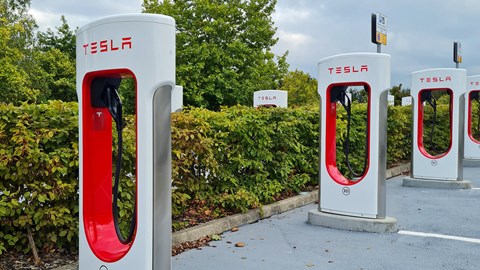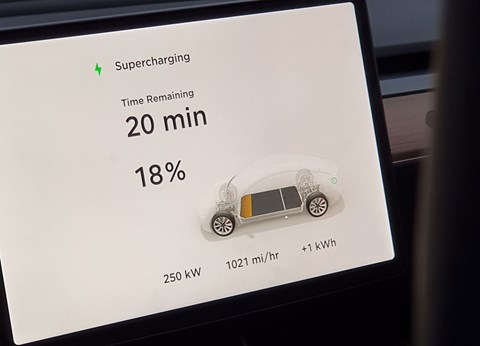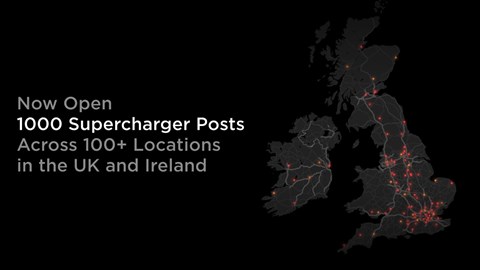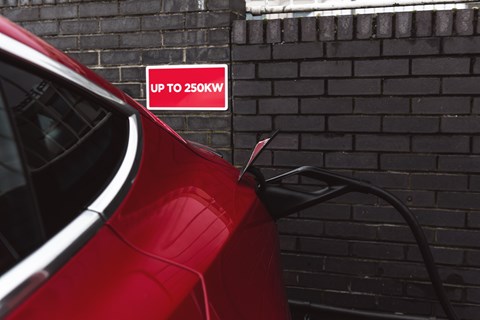► More than 1000 Tesla Superchargers in UK
► Open to Teslas and other brands
► Flexible pricing launched winter 2022/23
Welcome to CAR magazine’s guide to the Tesla Supercharger electric car charging network, one of the market-leading and most comprehensive EV charging networks in the UK.
The latest news is that Tesla is rolling out a flexible pricing model across the UK Supercharger network – bringing off-peak charging at 54p per kilowatt hour for most of the day, ramping up to 67p between 4pm-8pm every day of the week.
The company pledges to adjust those prices regularly, as the cost of energy changes. The prices are standardised for owners of Teslas and other brands using the network.
How many Tesla Superchargers are there in the UK?
The specialist EV brand has now installed 1000 Superchargers in the UK and Ireland, and these can be found at over 100 locations. Eight years after the first Tesla Supercharger ‘stall’ went live at the Royal Victoria Dock in London in 2014, the 1000th example was opened in 2022 at the London Sidcup Supercharger location at Ruxley Manor, just off the A20.
Tesla’s bespoke electric car charging network can be found throughout the UK mainland – as well as in Europe and beyond – and is widely recognised as one of the best public charging solutions available; 177 additional chargers have been added in 2022 so far, some at 17 entirely new Supercharger locations.

Previously limited to Tesla drivers only, a trial has seen some Superchargers locations opened up for use by any electric car owner.
Tesla Supercharger trial: allowing other brands access
The trial allowing non-Tesla electric cars to use the firm’s Supercharger network for the first time came to the UK in May 2022. Previously, owners of other brands’ EVs were unable to plug in to the American firm’s rapid chargers, meaning you had to be the driver of a Model S, Model 3, Model X or Model Y to benefit.
Elon Musk announced the trial in 2021 and it rolled out first in the Netherlands – but Tesla subsequently added Spain, Belgium, Sweden, Austria and the UK.

The company says it is ‘closely monitoring each site for congestion’ having promised Tesla drivers that further stations would only welcome other EVs if there was ‘available capacity.’
How do non-Tesla drivers charge up at a Supercharger?
Non-Tesla owners can start Supercharging in selected locations by downloading the Tesla app; at first they were charged more than Tesla owners, paying around 77p per kilowatt hour at time of writing (prices varied by site) versus the 67p per kWh standard rate enjoyed by Tesla drivers – but that was rolled back in winter 2022/23, as Tesla standardised the rate for all users.
Charging costs can be ‘lowered with a charging membership’ costing £10.99 a month in the UK, according to the firm. Full details of how to charge are here.
To start with, just 15 Tesla Supercharger stations have opened up in Great Britain. That’s a total of 158 Superchargers or around one in four sites, the company says. ‘We will eventually welcome both Tesla and non-Tesla drivers at every Supercharger worldwide,’ Tesla said.
Rapid Tesla Supercharger network growth
Back in 2020, Tesla installed its 500th UK Supercharger on the A12 outside Colchester. By 2021, that number increased to 624 chargers across 73 locations. Now in 2022 there are more than 1000 Supercharger stalls – as Tesla officially calls them – in over 100 locations. You can see how swiftly progress is moving here.
 Map of the Tesla Supercharging Network in the UK and Ireland
Map of the Tesla Supercharging Network in the UK and Ireland
Tesla’s chargers are already a common sight in service stations and car parks across the UK, and the company says there are now more than 30,000 charging points and in excess of 3000 stations worldwide. The Supercharger network is one of the main reasons that Tesla electric car ownership has been so viable, even for early adopters; it works seamlessly and hasn’t suffered from the reliability issues that some other networks are notorious for.
You’ll probably have seen the banks of futuristic-looking white stalls at motorway service stations dotted around the UK’s main trunk road network. Owners can see where the stations are on their sat-nav, which also indicates which chargers are in use and which are unoccupied. So while the cost of charging an electric car continues to rise as energy prices keep climbing, Tesla does at least show how to make it as convenient as possible.
What is the latest Tesla V3 Supercharging?
V3 Supercharging uses the same principle as Tesla’s previous Superchargers, but adds a 1MW power cabinet to the equation. That means 250kW peak charging rates per car, with Tesla saying a Long Range Model 3 can theoretically top up 75 miles of range in just five minutes.

What’s more, V3 charging also means no shared power – so charging speed won’t be hindered when two Teslas charge up together. Handy for those peak busy hours.
The UK’s first V3 Superchargers were installed at Park Royal in London in 2019, using CCS cables that have become the norm on other high-speed charging networks. These can plug into the Model 3 and Model Y directly, while the Model S and Model X are supplied with adaptors. As a result the latter pair will only enjoy maximum charging rates of around 145kW.
Any other recent changes?
Alongside the infrastructure upgrades with V3, Tesla has also rolled out an over-the-air update called On-Route Battery Warm-up. Batteries are essentially portable chemical reactions, and their efficiency is sensitive to heat.
Tesla’s new warm-up feature gets the cells at the ideal temperature for charging on the way to the charger, and that means when the car is connected to the Supercharger, power transfer is as efficient as possible – right from the start. The result? More miles for your time stationary.
In 2019, Tesla announced that its V2 Superchargers would be upgraded to unlock charging speeds of up to 145kW.
How much does Supercharging cost?
This has become a bit of a minefield over the years. All Tesla EVs used to come with free Supercharging, but lately the company has been phasing that offer out… before reintroducing it for certain periods to entice new customers. Our advice is to check before you buy, especially if you’re looking at secondhand models.
Charging costs vary, especially in the current climate of volatile energy prices. When running a Tesla Model S long-termer in 2018, CAR consumed £294 of power over 5600 miles, the equivalent of just 5p a mile. That’s cracking value and the (since discontinued) 85D’s 200-mile usable range meant we could easily take it on long trips to the other end of the country – so long as we factored in charging times and the detours occasionally required to find working charging points on our way.

However, in September 2022 there’s increasing evidence to suggest that electric car charging costs have reached parity with petrol and diesel on some public charging networks. So you may need to do some careful maths to work out whether the guide prices of 67p per kWh for Tesla drivers and 77p per kWh for non-Tesla drivers makes economic sense. If you’re able to charge at home, and can access off-peak pricing on a dedicated EV charging electricity tariff, electric cars remain the cheapest choice, however.
How to plan a trip with Tesla Superchargers
Tesla has launched a journey planner which helps you map out any route with your EV. And because the tool is specific to Tesla, it’s able to carefully calculate your route based on the range of your car. It’ll also favour Tesla’s own speedier Supercharger network, too. You can try the tool out here.
With every new Supercharger station that comes online that task gets easier and easier, and the Model S’s 405-mile range has massively reduced the need to stop en route. But be warned: there are still large swathes of rural Britain where charging up is not as easy as it should be.